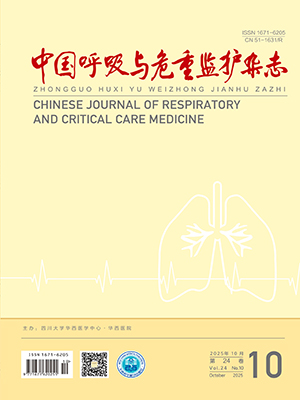| 1. |
陈典, 隆寰宇, 李姝润, 等. 2024年GOLD慢性阻塞性肺疾病诊断、治疗、管理及预防全球策略更新要点解读. 中国全科医学, 2024, 27(13): 1533-1543+1567.
|
| 2. |
王鹏程, 袁林栋, 许文娟, 等. 慢性阻塞性肺疾病急性加重严重程度评估研究进展. 中国呼吸与危重监护杂志, 2024, 23(3): 206-210.
|
| 3. |
Yin P, Wu J, Wang L, et al. The burden of COPD in China and its provinces: findings from the global burden of disease study 2019. Front Public Health, 2022, 10: 859499.
|
| 4. |
GBD 2019 Universal Health Coverage Collaborators. Measuring universal health coverage based on an index of effective coverage of health services in 204 countries and territories, 1990-2019: a systematic analysis for the global burden of disease study 2019. LANCET, 2020, 396(10258): 1250-1284.
|
| 5. |
Samarghandi A, Ioachimescu OC, Qayyum R. Association between peak inspiratory flow rate and hand grip muscle strength in hospitalized patients with acute exacerbation of chronic obstructive pulmonary disease. PLoS One, 2020, 15(1): e0227737. DOI: 10.1371/journal. pone.0227737.
|
| 6. |
Panigone S, Sandri F, Ferri R, et al. Environmental impact of inhalers for respiratory diseases: decreasing the carbon footprint while preserving patient-tailored treatment. BMJ Open Respir Res, 2020, 7(1): e000571.
|
| 7. |
Mahler, DA. The role of inspiratory flow in selection and use of inhaled therapy for patients with chronic obstructive pulmonary disease. Resp Med, 2019, 161: 105857.
|
| 8. |
Mahler DA, Halpin DMG. Personalizing selection of inhaled delivery systems in chronic obstructive pulmonary disease. Ann Am Thorac Soc, 2023, 20(10): 1389-1396.
|
| 9. |
冯婕, 金美玲, 张静, 等. 吸气峰流速测定对吸入装置个体化选择及精准药学服务的意义. 医药导报, 2022, 41(6): 839-842.
|
| 10. |
Mahler DA, Demirel S, Hollander R, et al. High prevalence of suboptimal peak inspiratory flow in hospitalized patients with COPD: a real-world study. Chronic Obstr Pulm Dis, 2022, 9(3): 427-438.
|
| 11. |
张静. 患者药物吸入能力评估上海专家共识. 上海医学, 2023, 46(1): 1-7.
|
| 12. |
彭咏怡, 高怡. 慢性气道疾病吸入疗法评估技术研究进展. 中国呼吸与危重监护杂志, 2022, 21(11): 832-836.
|
| 13. |
Represas-Represas C, Aballe-Santos L, Fernández-García A, et al. Evaluation of suboptimal peak inspiratory flow in patients with stable COPD. J Clin Med, 2020, 9(12): 3949.
|
| 14. |
Harb HS, Laz NI, Rabea H, et al. Prevalence and predictors of suboptimal peak inspiratory flow rate in COPD patients. Eur J Pharm Sci, 2020, 147: 105298.
|
| 15. |
Mahler DA, Niu X, Deering KL, et al. Prospective evaluation of exacerbations associated with suboptimal peak inspiratory flow among stable outpatients with COPD. Int J Chron Obstruct Pulmon Dis, 2022, 17: 559-568.
|
| 16. |
Ghosh S, Pleasants RA, Ohar JA, et al. Prevalence and factors associated with suboptimal peak inspiratory flow rates in COPD. Int J Chron Obstruct Pulmon Dis, 2019, 14: 585-595.
|
| 17. |
Mahler, DA, Watz H, Emerson-Stadler R, et al. Clinical implications of peak inspiratory flow in COPD: post hoc analyses of the TRONARTO Study. Int J Chron Obstruct Pulmon Dis, 2023, 18: 1729-1740.
|
| 18. |
Sharma G, Mahler DA, Mayorga VM, et al. Prevalence of low peak inspiratory flow rate at discharge in patients hospitalized for COPD exacerbation. Chronic Obstr Pulm Dis, 2017, 4(3): 217-224.
|
| 19. |
Suriyakul A, Saiphoklang N, Barjaktarevic I, et al. Correlation between hand grip strength and peak inspiratory flow rate in patients with stable chronic obstructive pulmonary disease. Diagnostics(Basel), 2022, 12(12): 3050.
|
| 20. |
Farkas Á, Horváth A, Réti I, et al. Comparative study of the inhalation parameters of COPD patients through NEXThaler® and Ellipta® dry powder inhalers. RESP MED, 2024, 224: 107576.
|
| 21. |
Clark AR, Weers JG, Dhand R. The confusing world of dry owder inhalers: it is all about inspiratory pressures, not inspiratory flow rates. J Aerosol Med Pulm Drug Deliv, 2019, 33(1): 1-11.
|
| 22. |
Tsuburai T, Komase Y, Tsuruoka H, et al. The relationship between peak inspiratory flow and hand grip strength measurement in men with mild chronic obstructive pulmonary disease. BMC Pulm Med, 2022, 22(1): 65.
|
| 23. |
Pleasants RA, Henderson AG, Bayer V, et al. Effect on physical position of peak inspiratory flow in stable COPD: an observational study. Chronic Obstr Pulm Dis, 2024, 11(2): 174-186.
|
| 24. |
Hua JL, Ye XF, Du CL, et al. Optimizing inhalation therapy in the aspect of peak inhalation flow rate in patients with chronic obstructive pulmonary disease or asthma. BMC Pulm Med, 2021, 21(1): 302.
|
| 25. |
Kainu A, Vartiainen VA, Mazur W, et al. Successful use of Easyhaler® dry powder inhaler in patients with chronic obstructive pulmonary disease; analysis of peak inspiratory flow from three clinical trials. Pulm Ther, 2024, 10(1): 133-142.
|
| 26. |
W H Kocks J, Wouters H, Bosnic-Anticevich S, et al. Factors associated with health status and exacerbations in COPD maintenance therapy with dry powder inhalers. NPJ Prim Care Respir Med, 2022, 32(1): 18.
|
| 27. |
Vartiainen VA, Lavorini F, Murphy AC, et al. High inhaler resistance does not limit successful inspiratory maneuver among patients with asthma or COPD. Expert Opin Drug Del, 2023, 20(3): 385-393.
|
| 28. |
Jõgi R, Mattila L, Vahteristo M, et al. Inspiratory flow parameters through dry powder inhalers in healthy volunteers and patients with chronic obstructive pulmonary disease(COPD): device resistance does not limit use in COPD. Int J Chron Obstruct Pulmon Dis, 2021, 16: 1193-1201.
|
| 29. |
Hanon S, Vanderhelst E, Buls N, et al. Getting the most out of spirometry: a tool to guide dry powder inhaler use. Respiration, 2022, 101(10): 893-900.
|
| 30. |
Leving MT, van Boven JFM, Bosnic-Anticevich SZ, et al. Suboptimal peak inspiratory flow and critical inhalation errors are associated with higher COPD-related healthcare costs. Int J Chron Obstruct Pulmon Dis, 2022, 17: 2401-2415.
|




